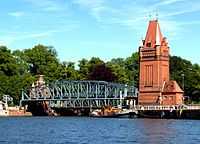Elbe–Lübeck Canal

The Elbe–Lübeck Canal (also known as "Elbe-Trave Canal") is an artificial waterway in Schleswig-Holstein, Germany. It connects the Elbe and Trave rivers, hence constituting an accessway from the Elbe to the Baltic Sea. It is 67 kilometres (42 mi) long; the northern terminus is Lübeck, the southern terminus is the town of Lauenburg. The town of Mölln is along the canal.
The predecessor was the Stecknitz Canal, built under Eric IV, Duke of Saxe-Lauenburg, between 1390 and 1398, making it one of the oldest artificial waterways of Europe. This canal connected the tiny rivers Stecknitz (tributary of the Trave) and Delvenau (tributary of the Elbe). It was a part of the Old Salt Route. The Stecknitz Canal was 85 centimetres (33 in) deep, 7.5 metres (25 ft) wide and 94 kilometres (58 mi) long. The canal included 17 wooden locks (of which the Palmschleuse at Lauenburg still exists) that managed the 13-metre (43 ft) elevation difference between its endpoints and the highest central part, the Delvenaugraben.[1]
According to authors David Kirby and Merja-Liisa Hinkkanen, "the journey (along the Stecknitz) often lasted up to fourteen days, due to the number of locks and the inadequacy of the towpath. A number of plans for a new Baltic–North Sea canal were floated in the 17th century, but none came to fruition."[2]
In 1900 the original Stecknitz canal was replaced by the present Elbe–Lübeck Canal. It was partly laid out using the Stecknitz, the Delvenau and the old canal. The canal bed was generally straightened, thus reducing the length to the current 67-kilometre (42 mi) figure.
References
External links
| Wikimedia Commons has media related to Elbe-Lübeck Canal. |
Coordinates: 53°33′00″N 10°40′53″E / 53.55000°N 10.68139°E